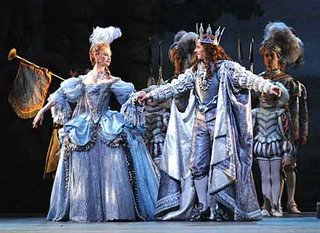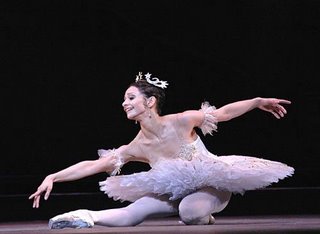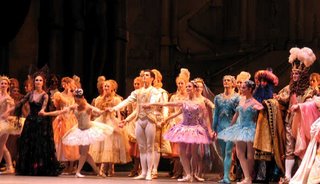The Royal Ballet: Sleeping Beauty
Sarah Kaufman, Royal Ballet Weaves Its Meticulous Spell (Washington Post, June 24) John Rockwell, Reviving 'Beauty' With Old-School Poise and Reserve (New York Times, June 24) Jean Battey-Lewis, Dusty Royal gems polished (Washington Times, June 24) Philip Kennicott, 'Beauty' Reawakened (Washington Post, June 21) |
Sleeping Beauty is a showcase and an ultimate test for a ballet company. Beauty is not easily achieved: its grand staging comes with a big price tag; and its extremely challenging choreography requires the finest dancers. It’s an unattainable dream for many dance troupes and each (successful) new production is a cultural event in the ballet world.
The Royal Ballet has been on a quest for its own Beauty since 1939. The most recent attempts to resurrect the famous ballet ended unhappily, a 2003 production of Natalia Makarova was doomed as “too Kirov” and Anthony Dowell’s 1996 modern staging as plain “ugly.” Nevertheless, the company was determined to bring the magic back. This time the management decided to play it safe, choosing to revisit the popular 1946 version based on Oliver Messel’s stage decorations and Frederick Ashton’s additional choreography. Last week the Royal Ballet unveiled this new-old Beauty at the Kennedy Center Opera House.
 (Photograph by John Ross / www.ballet.co.uk) |
It is the curse of a second night’s performance that it is traditionally handed to a second-string cast. The Royal corps’s maidens in the beginning of the Prologue weren’t quite together, not an uncommon sight that night. Ballerinas’ heads and feet moving in different directions coupled with muddled sounds coming from the orchestra pit set a mood matching the gloomy sets right from the start. The cavalcade of good fairies with their cavaliers following brought a welcome change in the color scheme. Isabel McMeekan as the Lilac Fairy rescued the dancing part. She was a centerpiece of the party, dancing with grace, eloquence, and vigor. The arrival of the Wicked Fairy Carabosse in a dead-crow cart powered by six giant rats was rather more grotesque than ominous. Dressed in a long black sparkling dress, Genesia Rosato as Carabosse (the character role often performed by a male) was eccentric and bizarre.
 (Photograph by John Ross / www.ballet.co.uk) |
After the first act the performance finally took off. Imaginative designs and beautiful dancing in the Vision Scene of the second act brought some magic to the production. A charismatic dancer with an impressive virtuoso technique, Federico Bonelli gave a solid portrayal of Prince Florimund. He partnered Aurora with assurance and elegance. Young and exuberant, Marquez and Bonelli made a beautiful couple; their passionate duet in the enchanted forest was not only danced agreeably but acted very well, too.

The ballet culminates in the wedding of Princess Aurora and Prince Florimund. The festivities begin with a parade and divertissements of well-known fairytale characters. Little Red Riding Hood (Caroline Duprot) was particularly memorable not only for her enticing performance but also for the bright red cloak. Brian Maloney as the Blue Bird spent most of his solo in the air, demonstrating his ability to fly; Bethany Keating was a charming White Cat, flanked by Jonathan Howells as Puss-in-Boots. The glorious grand pas de deux of the lead dancers followed by the nuptial ceremony concluded the evening satisfyingly.
Whether this sort of Beauty appeals to you will depend on your expectations from the genre. The glory of the past can’t quite be recaptured – but good dancing will assuage those who expect classical ‘classical ballet’.





















































No comments:
Post a Comment